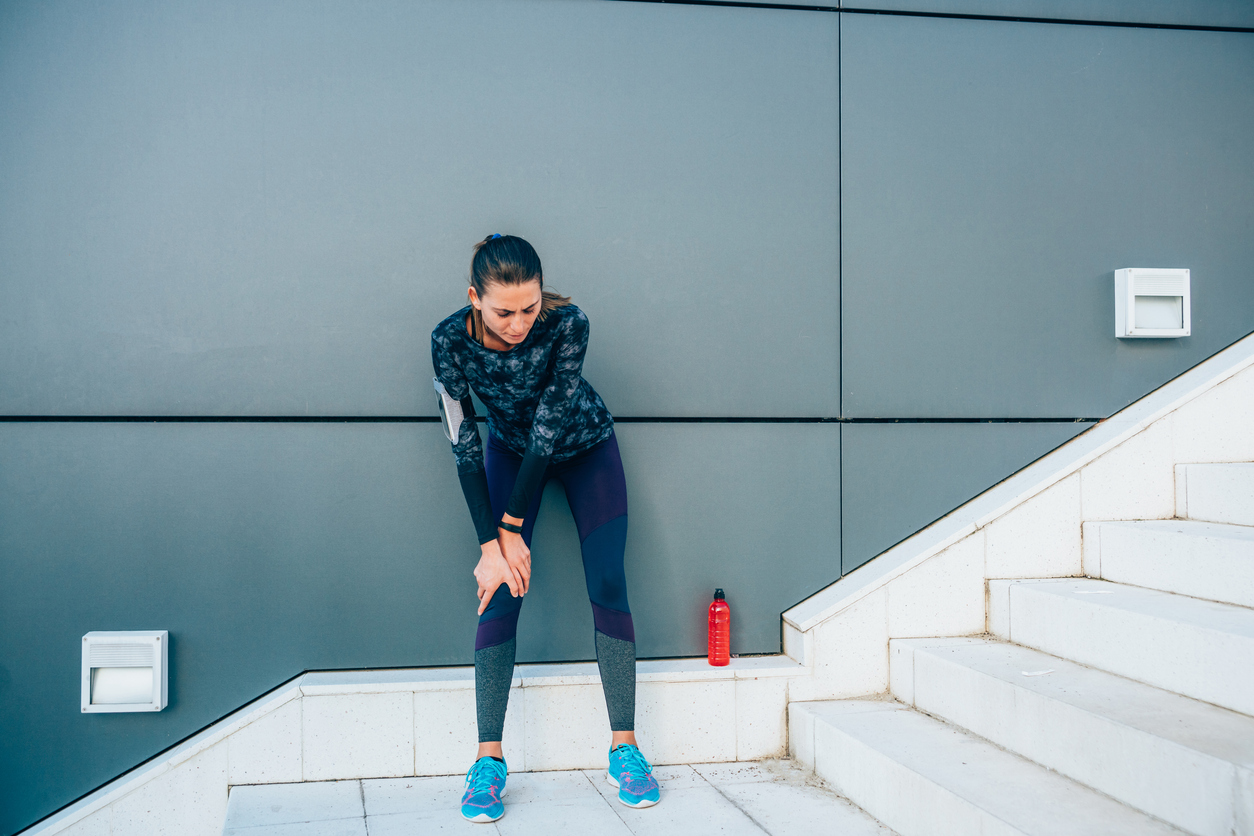A common complaint about knee pain is aching when climbing up and down stairs. While running or walking stairs is a great form of cardiovascular exercise, it does put strain on the knees. If you experience knee pain going up or down stairs, it may be time to consult with a physical therapist.
Knee Anatomy 101
In order to get an understanding of knee pain, it helps to visualize the internal structure of a knee. The knee joins four bones: the fibula (non-weight bearing bone in the lower leg), the patella (or kneecap), the tibia (or shin bone), and the femur (or thigh bone).
The femur connects above the knee joint, while the patella rests in the groove of the femur at the front of the knee joint. The tibia and fibula connect below the knee joint. These four bones are supported by ligaments, tendons, and muscles to help keep the knee stable and mobile.
These bones work in concert when you bend your leg to walk up or down stairs. The patella slides over the femur, and in a healthy knee, articular cartilage keeps the kneecap stable, cushioned, and provides lubrication to the knee joint. There are many common issues that could cause knee pain going up and down stairs: muscle imbalances or tightness causing poor tracking of the patella, meniscal tears, ligament tears, bursitis, tendonitis, and/or arthritis.
What Causes Knee Pain When Going Up and Down Stairs?
Knee pain can be caused by several different things. It’s important to remember the amount of force exerted on a knee. When walking on level ground, the knee handles 1.5 times a person’s body weight. According to Health.Harvard.Edu: “That means a 200-pound man will put 300 pounds of pressure on his knees with each step. Add an incline, and the pressure is even greater: the force on each knee is two to three times your body weight when you go up and down stairs, and four to five times your body weight when you squat to tie a shoelace or pick up an item you dropped.”
Knee Osteoarthritis
The cartilage that supports your knee breaks down over time, causing bones to move without proper cushioning and with irregularity. Knee osteoarthritis affects millions of people in the United States and common symptoms include grinding or clicking in the knee when its moved, pain, inflammation, and stiffness after periods of prolonged sitting.
Patellofemoral Pain Syndrome
More commonly known as runner’s knee, patellofemoral pain syndrome refers to anterior knee pain. Runner’s knee is a common cause of knee pain and occurs when the kneecap is moved irregularly, which causes damage to the soft tissues around the knee joint. Symptoms include a grinding or clicking in the knee or swelling and pain in the kneecap. Patellofemoral pain may occur because of flat feet, muscle weakness, or anatomical abnormalities.
Ligament Injury
Another common cause of knee pain is if the ACL or MCL has been injured or torn. If either of these ligaments have been injured, you’ll likely experience pain going up and down stairs.
Compensation Injury
If you’ve injured your foot, ankle, or other body part, you’ll tend to compensate for the injury without really noticing it. By compensating for another injury, you alter your body’s natural movement and put excessive load on the knee.
IT Band Syndrome
The IT band, or iliotibial, is a band of tendon running from the pelvis to the top of the shin and over the side of the knee. If you do repetitive knee-bending activities such as running, biking, or hiking, the IT band could become inflamed, and therefore cause knee pain when ascending or descending stairs.
Meniscus Tears
Meniscus tears are another common kind of knee injury. Athletes who play contact sports are especially at risk for meniscus tears. This knee injury can cause clicking, popping, and pain or a sensation of “giving out” particularly when descending stairs.
Improve Knee Pain with Telehealth Physical Therapy
A physical therapist can help with knee pain. Agile Virtual Therapy can connect you with a licensed physical therapist who will consult with you and prescribe a personalized plan to strengthen the muscles around the knee for improved stability, mobility, and decreased pain. Best of all, the entire course of care can be completed from the comfort of your own home. Schedule an appointment today to regain your mobility and reduce nagging knee pain!

